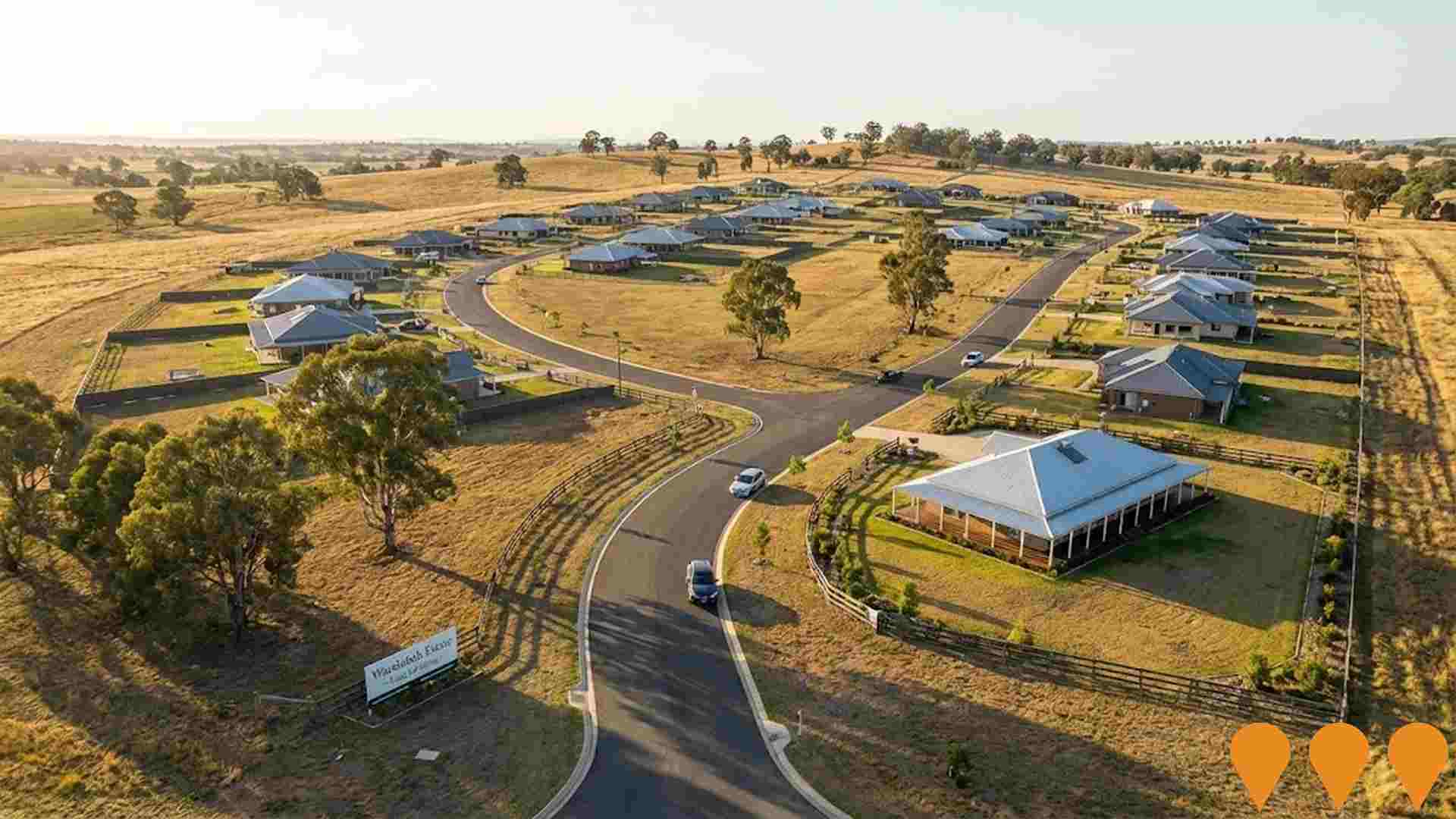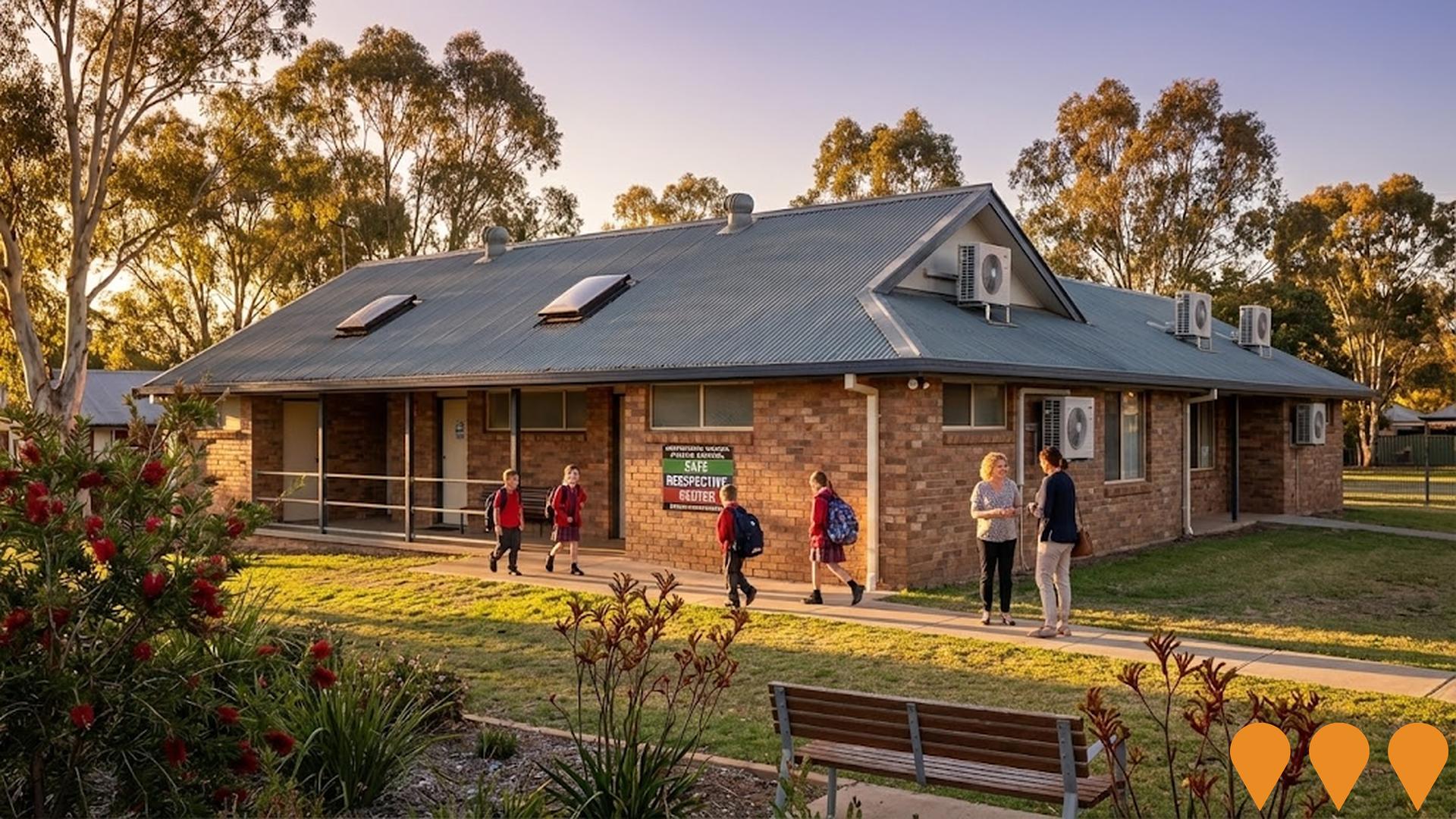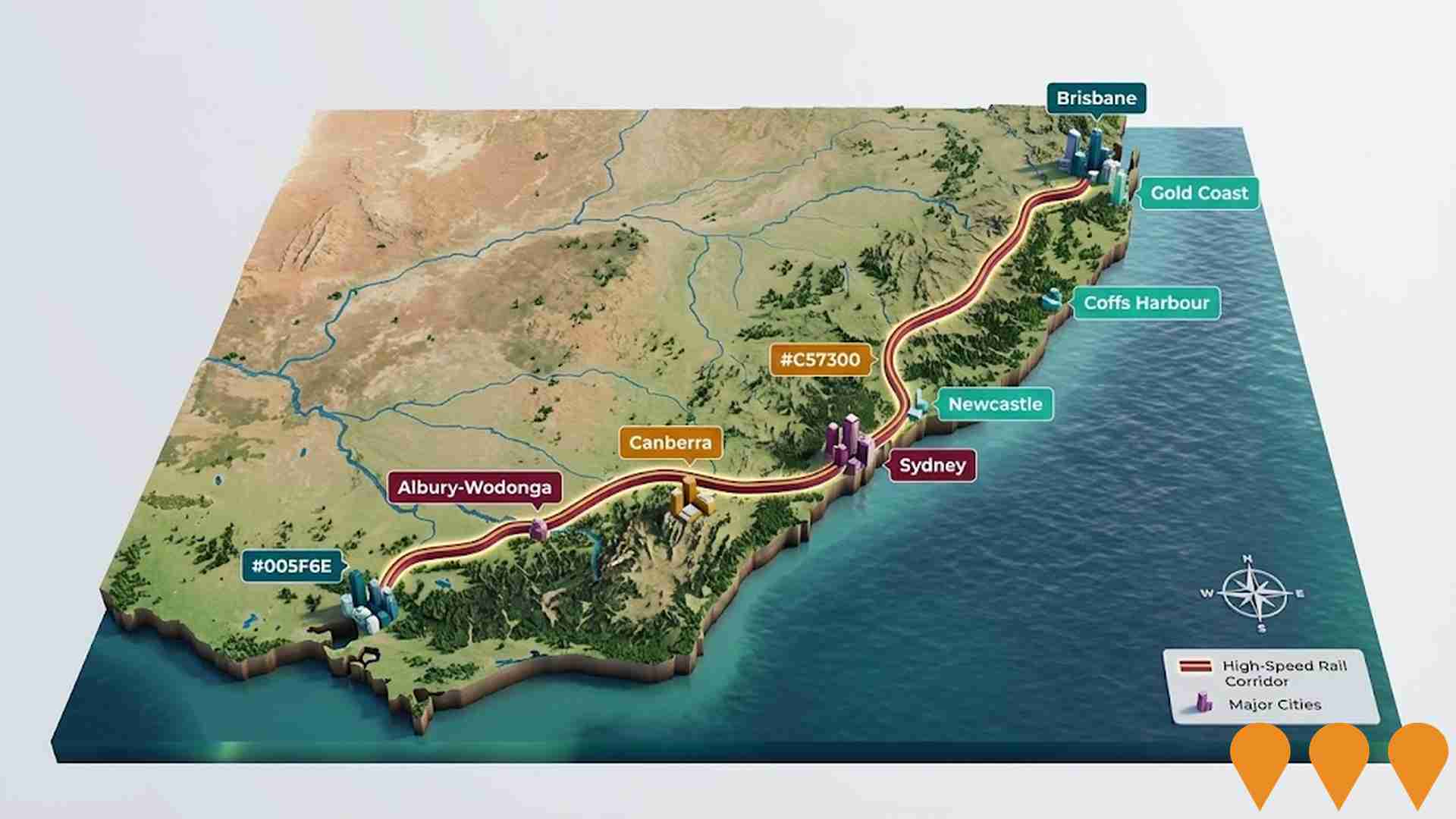Chart Color Schemes
est. as @ -- *
ABS ERP | -- people | --
2021 Census | -- people
Sales Activity
Curious about local property values? Filter the chart to assess the volume and appreciation (including resales) trends and regional comparisons, or scroll to the map below view this information at an individual property level.
Find a Recent Sale
Sales Detail
Population
Population growth drivers in Gunnedah are strong compared to national averages based on AreaSearch's ranking of recent, and medium to long-term trends
Gunnedah's population was approximately 10,162 as of November 2025. This figure represents an increase of 417 people since the 2021 Census, which recorded a population of 9,745. The growth is inferred from the estimated resident population of 10,095 in June 2024 and an additional 91 validated new addresses since the Census date. This results in a density ratio of 112 persons per square kilometer. Over the past decade, Gunnedah's population grew at a compound annual growth rate of 0.8%, outperforming its SA4 region. Natural growth contributed approximately 54.1% to overall population gains during recent periods.
AreaSearch uses ABS/Geoscience Australia projections for each SA2 area, released in 2024 with a base year of 2022. For areas not covered by this data, NSW State Government's SA2 level projections, released in 2022 with a base year of 2021, are utilized. Growth rates by age group from these aggregations are applied to all areas for the years 2032 to 2041. Nationally, non-metropolitan areas are projected to have above median population growth, with Gunnedah expected to expand by 1,341 persons to 2041 based on the latest population numbers, indicating a total gain of 12.5% over the 17 years.
Frequently Asked Questions - Population
Development
Residential development activity is lower than average in Gunnedah according to AreaSearch's national comparison of local real estate markets
Gunnedah has seen approximately 42 new homes approved annually. Between FY-21 and FY-25211 homes were approved, with an additional 7 approved in FY-26 to date. On average, 1.5 new residents per year per dwelling constructed have been recorded over the past five financial years. However, this figure has increased to 5 people per dwelling over the last two years, indicating growing demand and tightening supply.
The average construction value of development projects is $284,000, aligning with regional norms. This year alone, there have been $22.7 million in commercial approvals, suggesting moderate levels of commercial development. Compared to the rest of NSW, Gunnedah exhibits similar construction activity per capita, maintaining market balance consistent with broader trends.
Recent construction comprises 73.0% detached houses and 27.0% medium and high-density housing, preserving the area's traditional low-density character focused on family homes. The estimated population count per dwelling approval is 596 people, reflecting its quiet development environment. Future projections indicate Gunnedah will add approximately 1,274 residents by 2041. Current construction rates appear balanced with future demand, fostering steady market conditions without excessive price pressure.
Frequently Asked Questions - Development
Infrastructure
Gunnedah has emerging levels of nearby infrastructure activity, ranking in the 30thth percentile nationally
The performance of an area is significantly influenced by changes to local infrastructure, major projects, and planning initiatives. AreaSearch has identified 14 such projects that are expected to impact the area. Notable projects include Gunnedah Hospital Redevelopment, Whitehaven Coal Mornington Estate Development, Cohens Bridge Rehabilitation, and Eucalypt Lifestyle and Retail Precinct. The following list details those projects likely to be most relevant:.
Professional plan users can use the search below to filter and access additional projects.
INFRASTRUCTURE SEARCH
 Denotes AI-based impression for illustrative purposes only, not to be taken as definitive under any circumstances. Please follow links and conduct other investigations from the project's source for actual imagery. Developers and project owners wishing us to use original imagery please Contact Us and we will do so.
Denotes AI-based impression for illustrative purposes only, not to be taken as definitive under any circumstances. Please follow links and conduct other investigations from the project's source for actual imagery. Developers and project owners wishing us to use original imagery please Contact Us and we will do so.
Frequently Asked Questions - Infrastructure
Gunnedah 1000 New Homes Strategic Plan
Strategic planning framework, including the Local Housing Strategy (updated May 2024), to facilitate the delivery of up to 1000 new homes by 2040 through rezoning, infrastructure development, and streamlined planning processes. This includes a $202,500 NSW Government grant for housing planning work such as a new Development Control Plan, Local Contributions Plan, and water/sewer network assessments to support new residential areas and community facilities.

Gunnedah Hospital Redevelopment
The NSW Government's $53 million redevelopment of Gunnedah Hospital will deliver a new acute services building, housing an expanded emergency department, a modern birthing, maternity, and inpatient unit, and a new main entry/reception. The project is delivered by Health Infrastructure in partnership with Hunter New England Local Health District and built by Richard Crookes Constructions. Construction is well progressed with building commissioning underway, and the project is on track for completion by the end of 2025. A community open day for the new building was held on November 26, 2025, ahead of the official opening.
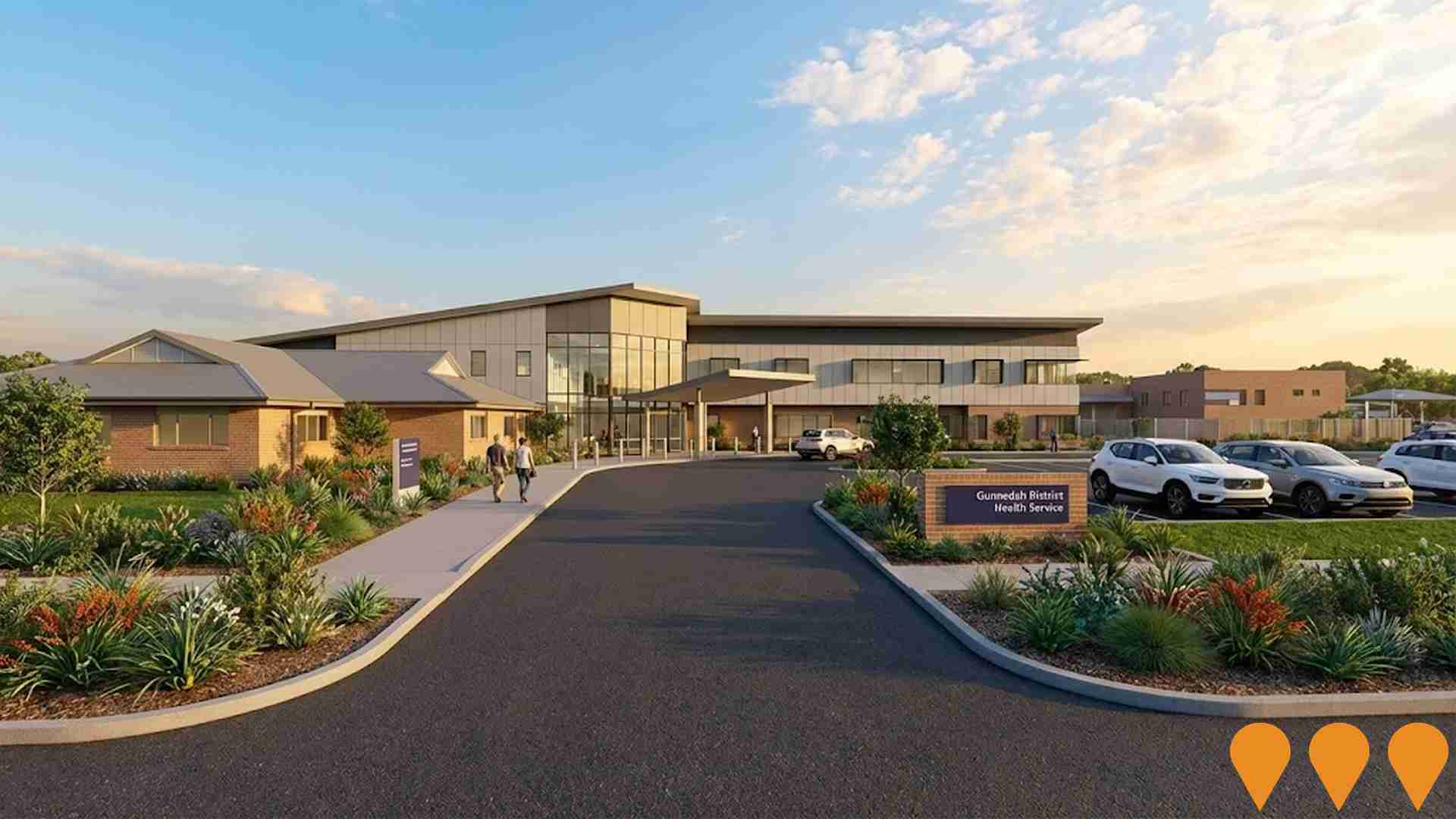
Gunnedah Solar Farm
The 110MW (or 154MW DC) utility-scale solar farm, now owned by CalEnergy Resources (a subsidiary of Northern Powergrid/Berkshire Hathaway Energy) and formerly developed by Canadian Solar, has reached substantial completion and is operational. Located on 304 hectares, it uses 460,000 bifacial panels on a single-axis tracking system. It can power approximately 48,000 homes and has a long-term power purchase agreement with Amazon. It was registered to the grid in July 2021.

Eucalypt Lifestyle and Retail Precinct
A proposed lifestyle and retail precinct on a 6000m2 site with over 3000m2 lettable area, including parking for 80 cars, creating 40 construction jobs and over 100 operational jobs. Pre-leased spaces include 360 Fitness Club, 360 Health Clinic, and Country Rubber & Foam, Pools & Spas.

Whitehaven Coal Mornington Estate Development
Whitehaven Coal's residential development in Gunnedah providing housing for mining workforce and general community. Project includes approximately 170 lots and 90 dwellings across five years, with development on Redgum Road off Bottle Brush Avenue.

Gunnedah Regional Saleyards Redevelopment
Redevelopment of the regional saleyards including new multi-administration and buyers facility, new pens, improvements to internal roads, lighting, and site infrastructure. The holding pens, central draft area, and scales are now roofed, enhancing safety and improving animal welfare. Upgrades also include a truck-wash facility, new perimeter fencing, solar power installation, a water capture and reuse system, and improved dust suppression measures.

Gunnedah Sports Precinct Master Plans
Council-adopted master plans guiding staged upgrades to key sport and community precincts across Gunnedah, including the Showground and Riverine Precincts (Donnelly and Namoi Playing Fields and Woolshed Reserve), plus earlier-adopted plans for Kitchener Park and Wolseley Park. Works proposed include upgraded playing surfaces and fields, amenity and clubhouse improvements, parking and access upgrades, and new multi-purpose community facilities. With adoption, Council can now seek funding and commence implementation of priority projects.
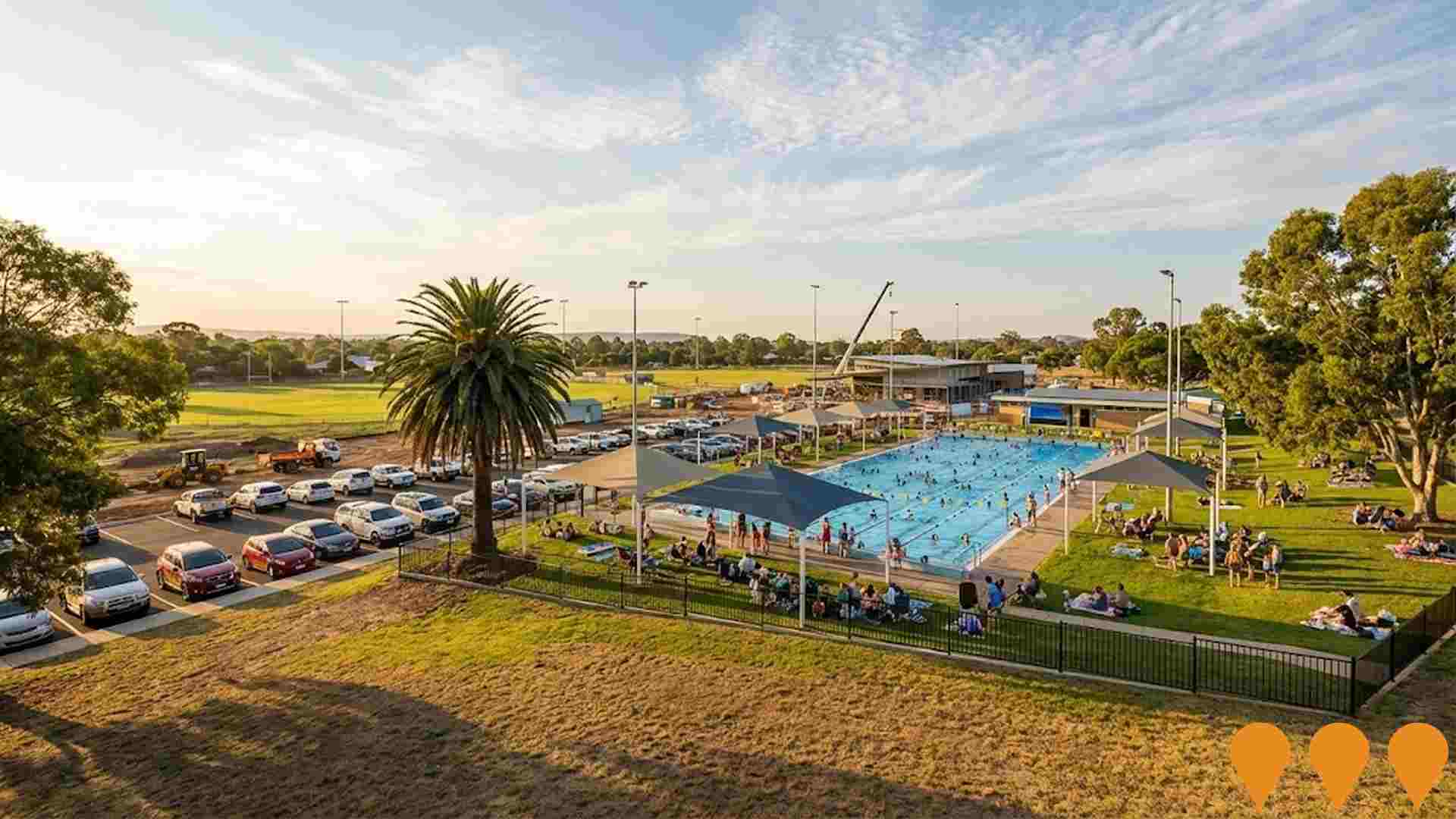
Sawmill Business Centre Stage 2
Second stage development of the Sawmill Business Centre providing additional commercial and light industrial facilities. Project includes new warehouse spaces, office buildings, and improved infrastructure to support local business growth.
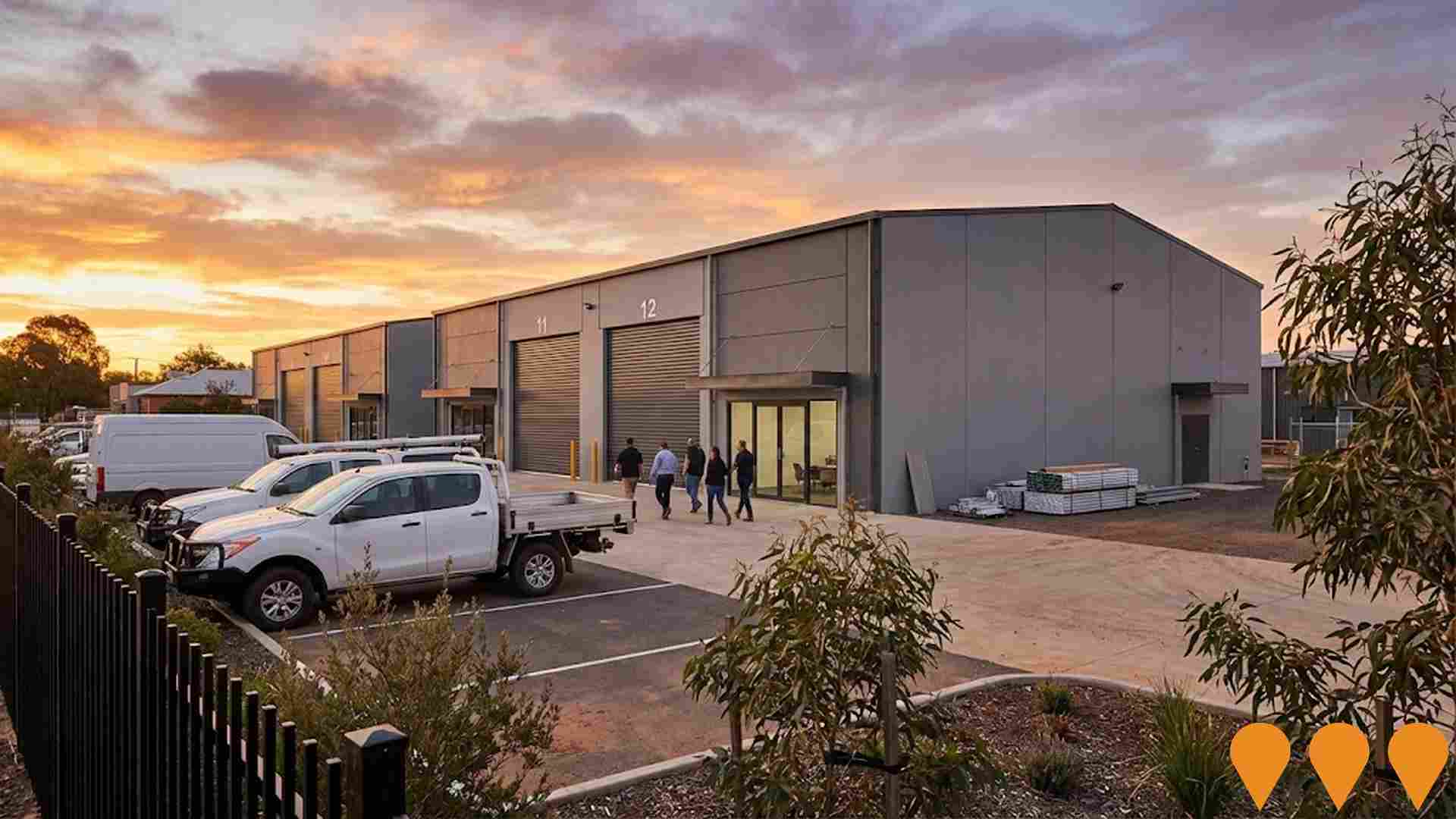
Employment
The exceptional employment performance in Gunnedah places it among Australia's strongest labour markets
Gunnedah has a balanced workforce with both white and blue collar jobs. Manufacturing and industrial sectors are prominent.
The unemployment rate in June 2025 was 1.7%. Employment growth over the past year was estimated at 4.0%. As of June 2025, 5,579 residents were employed, with an unemployment rate of 1.9%, below Rest of NSW's rate of 3.7%. Workforce participation was 59.3%, compared to Rest of NSW's 56.4%.
Major employment sectors for residents are mining, health care & social assistance, and education & training. Mining is particularly specialized, with an employment share 6.8 times the regional level. Conversely, health care & social assistance shows lower representation at 11.5% versus the regional average of 16.9%. Many residents commute elsewhere for work based on Census data. Over the year to June 2025, employment increased by 4.0%, labour force grew by 3.6%, reducing unemployment by 0.4 percentage points. In contrast, Rest of NSW had employment decline of 0.1% and labour force growth of 0.3%, with a rise in unemployment rate by 0.4 percentage points. Jobs and Skills Australia's national employment forecasts from May 2025 suggest potential future demand within Gunnedah. National employment is forecast to expand by 6.6% over five years and 13.7% over ten years, but growth rates vary between sectors. Applying these projections to Gunnedah's employment mix suggests local growth of approximately 5.3% over five years and 12.0% over ten years.
Frequently Asked Questions - Employment
Income
Income levels align closely with national averages, indicating typical economic conditions for Australian communities according to AreaSearch analysis
Gunnedah's median income among taxpayers was $53,499 and the average income stood at $68,854 in financial year 2022. This compares to Rest of NSW's figures of $49,459 and $62,998 respectively. By September 2025, current estimates suggest Gunnedah's median income would be approximately $60,245 and the average income $77,536, accounting for a Wage Price Index growth of 12.61%. According to 2021 Census figures, household incomes in Gunnedah ranked at the 42nd percentile, family incomes at the 40th percentile, and personal incomes at the 38th percentile. The largest income bracket comprised 30.9% of residents earning between $1,500 and $2,999 weekly. After housing costs, 85.8% of income remained for other expenses.
Frequently Asked Questions - Income
Housing
Gunnedah is characterized by a predominantly suburban housing profile, with a higher proportion of rental properties than the broader region
Gunnedah's dwelling structure, as per the latest Census, comprised 87.6% houses and 12.5% other dwellings (semi-detached, apartments, 'other' dwellings). Non-Metro NSW had 89.5% houses and 10.4% other dwellings. Home ownership in Gunnedah was 32.6%, with mortgaged dwellings at 34.2% and rented ones at 33.1%. The median monthly mortgage repayment was $1,500, matching Non-Metro NSW's average. Median weekly rent in Gunnedah was $300, the same as Non-Metro NSW's figure. Nationally, Gunnedah's mortgage repayments were lower at $1,500 compared to Australia's average of $1,863. Rents in Gunnedah were substantially below the national figure of $375.
Frequently Asked Questions - Housing
Household Composition
Gunnedah features high concentrations of lone person households, with a fairly typical median household size
Family households constitute 66.5% of all households, including 27.3% couples with children, 25.5% couples without children, and 12.3% single parent families. Non-family households account for the remaining 33.5%, with lone person households at 30.3% and group households comprising 3.3%. The median household size is 2.4 people, aligning with the average in the Rest of NSW.
Frequently Asked Questions - Households
Local Schools & Education
Gunnedah faces educational challenges, with performance metrics placing it in the bottom quartile of areas assessed nationally
Gunnedah has lower university qualification rates at 14.7% compared to NSW's average of 32.2%. Bachelor degrees are most common among qualifications at 10.7%, followed by postgraduate qualifications (2.4%) and graduate diplomas (1.6%). Vocational credentials are prominent, with 41.9% of residents aged 15+ holding such qualifications, including advanced diplomas (8.0%) and certificates (33.9%). Educational participation is high at 31.8%, with 13.6% in primary education, 8.0% in secondary education, and 2.6% pursuing tertiary education.
Seven schools operate in Gunnedah, educating approximately 2,204 students. The educational mix includes three primary schools, two secondary schools, and two K-12 schools. School capacity exceeds typical residential needs at 21.8 places per 100 residents compared to the regional average of 16.5, indicating Gunnedah serves as an educational center for the broader region.
Frequently Asked Questions - Education
Schools Detail
Nearby Services & Amenities
Transport
Transport servicing is moderate compared to other areas nationally based on assessment of service frequency, route connectivity and accessibility
Gunnedah has 216 active public transport stops. These include train and bus services. There are 38 routes operating in total, offering 803 weekly passenger trips collectively.
Residents enjoy excellent transport accessibility, with an average distance of 198 meters to the nearest stop. Service frequency is high, with 114 trips per day across all routes, equating to about three weekly trips per individual stop.
Frequently Asked Questions - Transport
Transport Stops Detail
Health
Health performance in Gunnedah is lower than average with prevalence of common health conditions notable across both younger and older age cohorts
Gunnedah faces significant health challenges with notable prevalence of common health conditions across both younger and older age cohorts. The rate of private health cover is approximately 54% of the total population (~5,456 people), compared to 50.0% across Rest of NSW.
The most common medical conditions are arthritis and asthma, impacting 9.1% and 9.1% of residents respectively. 65.3% of residents declare themselves completely clear of medical ailments, compared to 63.4% across Rest of NSW. As of 2016, 19.0% of residents are aged 65 and over (1,926 people). Health outcomes among seniors present some challenges, broadly in line with the general population's health profile.
Frequently Asked Questions - Health
Cultural Diversity
The latest Census data sees Gunnedah placing among the least culturally diverse areas in the country when compared across a range of language and cultural background related metrics
Gunnedah, as per the 2016 Census, had a cultural diversity below average with 88.8% of its population being Australian citizens, 93.7% born in Australia, and 95.9% speaking English only at home. Christianity was the predominant religion in Gunnedah, comprising 62.1%, compared to 63.6% across Rest of NSW. The top three ancestry groups were Australian (33.9%), English (28.1%), and Australian Aboriginal (12.1%).
Notable differences existed in Irish representation at 8.0% (vs regional 8.0%), South African at 0.3% (vs 0.2%), and Filipino at 0.8% (vs 0.7%).
Frequently Asked Questions - Diversity
Age
Gunnedah's population is slightly younger than the national pattern
The median age in Gunnedah as of 2021 was 36 years, which is significantly lower than the Rest of NSW's average of 43 years and somewhat younger than Australia's median age of 38 years. The 25-34 age group had a strong representation with 14.8% compared to the Rest of NSW figure. However, the 65-74 cohort was less prevalent at 9.1%. Post-2021 Census data showed that the 35 to 44 age group grew from 11.6% to 12.9% of the population, while the 55 to 64 cohort declined from 11.0% to 9.9%. Population forecasts for the year 2041 indicate substantial demographic changes in Gunnedah. Leading these shifts, the 45 to 54 group is projected to grow by 33%, reaching 1,315 people from its current figure of 985. Conversely, the 65-74 cohort is expected to decline by 49 people.


